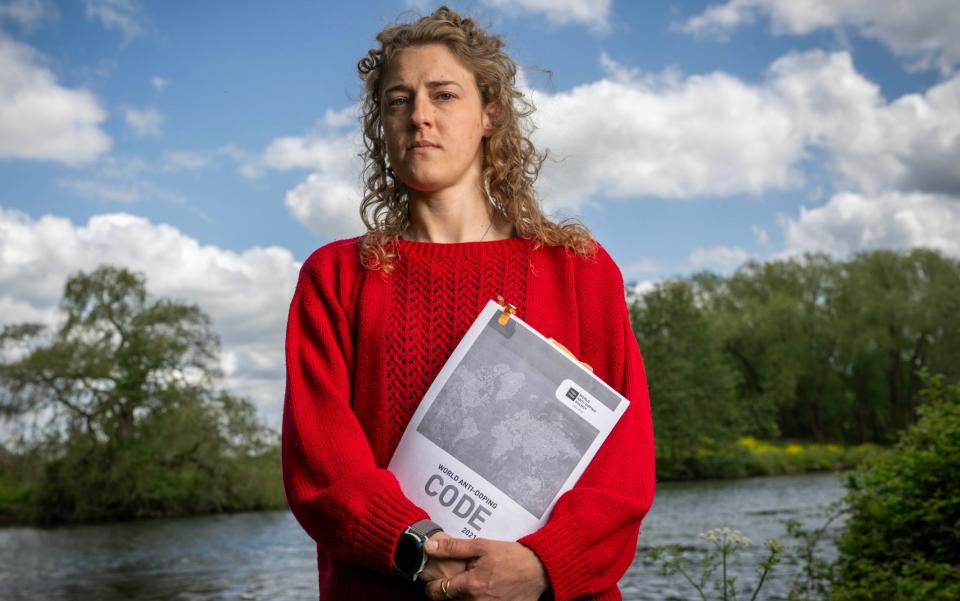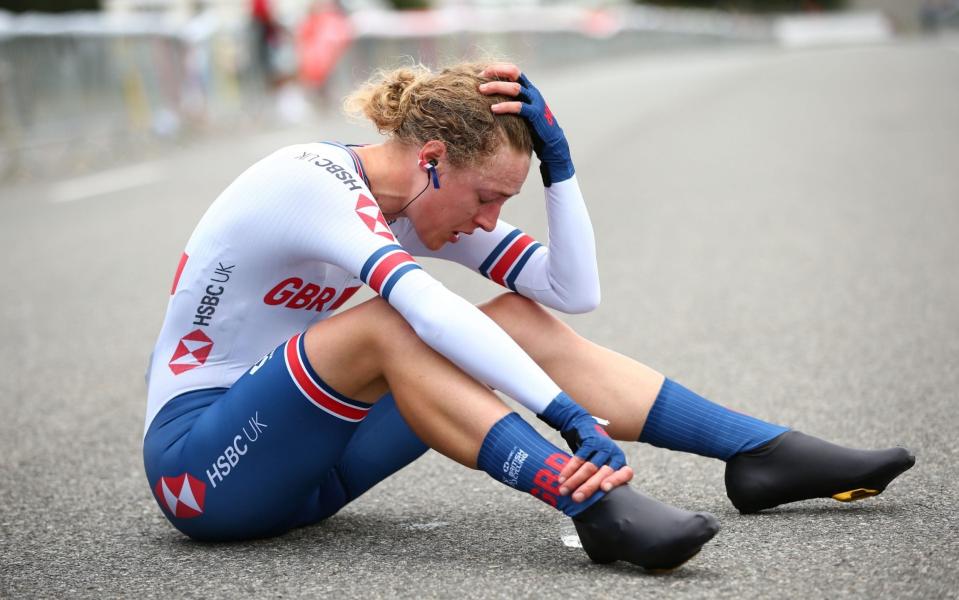Lizzy Banks interview: I fought flawed doping case and won – but Wada has cost me my career

Lizzy Banks will never forget where she was when she got the email from UK Anti-Doping, on July 28 last year, which would change her life. Having finally recovered from various setbacks which had stalled her professional cycling career – a serious concussion which wiped her out for the entire season in 2021, ending her Olympic dream, a bout of Covid that led to pericarditis in 2022 – she was finally back on the bike. Banks had just competed at the Giro d’Italia, the scene of her most famous wins, having taken stages there in 2019 and 2020, and was slowly working her way back to form and fitness.
“I was on a training ride near where I live in Geneva,” she recalls. “It was my first four-hour ride since the Giro. A hot day – 30C. I stopped for a Coke around halfway in a small village called Seyssel, near the Grand Colombier and went into a cafe and checked my phone… There was this email from Ukad saying they needed to send me something ‘private and confidential’. I just completely freaked out.”
She was right to do so. Banks, it turned out, had returned two Adverse Analytical Findings (AAF), with Ukad’s letter stating quite explicitly that she faced the prospect of a two-year ban unless she could establish the source. In a “blind panic”, she read on.
The first AAF was for formoterol, a medication she had been taking for years to treat asthma – “and always well below the permitted threshold, so I couldn’t understand that one”, she says. The second was for chlortalidone, a diuretic Banks had never heard of but which she quickly Googled. It was mainly used for high blood pressure and swellings. “That also didn’t make sense as I was sure it wasn’t present in any of my medications.”
So began a 10-month journey which, Banks says, destroyed her “in every way imaginable”; mentally, emotionally, professionally. She has been absolved of any blame now, having proved on the balance of probabilities that her test was contaminated. But the scars, she fears, may never heal.

Banks has spent her entire life savings. She has borrowed money off her foster brother and her in-laws. In total she reckons she and her husband spent upwards of £40,000 trying to prove her innocence. Her cycling career is over. She was provisionally suspended by her team pending the outcome of the investigation. And while that suspension has now lifted, at 33 she says she will “never go back” as she “couldn’t risk putting her family through something like this ever again”. She “officially” retires on Tuesday, without any fanfare.
Most seriously, Banks’ mental health deteriorated to such a degree that she has felt suicidal for much of the last year. She realises this will shock people and does not say this lightly. Banks had to see a psychiatrist and remains on anti-depressants.
It is the fear that someone in the same situation as her might take their own life that has caused her to go public with her story today. What she found during the course of her research (which ultimately culminated in a landmark climbdown from Ukad – this marks the first time the body has ever issued a finding of No Fault or Negligence and therefore zero sanction when an athlete has not specifically identified the exact source of a contamination) – shocked her to her core.
Banks estimates that hundreds of athletes may have returned positive tests because of contamination like hers. Many received bans. And the worst thing, she says, is that “Wada [World Anti-Doping Agency] have known there was something up here for years, and yet they’ve not done anything about it”.
Sitting in the sunshine in a cafe near Windsor, having driven overnight from Geneva, Banks takes a deep breath. She is clearly terrified by what the reaction to her story might be, despite the outcome of the case. She has been waiting for the 21-day appeal window to end before speaking. In theory, she says, Wada still has another 21 days in which it could appeal. But she is so exhausted she needs to get this off her chest now. She has medication in her bag “in case I have a complete meltdown”, which still happens from time to time.
Banks realises some people will not get past the headline: “Cyclist tests positive.” She says that is the problem. “Even with the finding of No Fault or Negligence, and no suspension, I still get four Anti-Doping Rule Violations – how is that fair?” she asks.
What she hopes is that people read her story and understand it before passing judgment. She believes that when they do, they will agree with her that Wada and Ukad’s rules “are not currently fit for purpose and require a complete overhaul”.
It is quite an accusation, particularly in light of recent events. Wada is facing what some have described as an “existential threat” after it emerged that 23 Chinese swimmers were quietly spared bans in 2021 after the world governing body decided it could not challenge the Chinese anti-doping agency’s verdict of “group contamination”. Travis Tygart, chief executive of the United States Anti-Doping Agency, told Telegraph Sport last week that the scandal was “worse than previous Russian controversies”.

Banks admits her trust in Wada has also nosedived through the course of her investigation, which was exhaustive. “My final submissions [for the Ukad tribunal that never was] were 144 pages and over 40,000 words,” she says.
It is worth noting that Banks is uniquely well-qualified for such a task. She trained as a doctor, quitting her medical studies shortly before graduating in order to pursue her cycling career. She was, she says, (relatively) well-paid, well-supported, and admits to having the sort of character that if she is threatened with a ban for something of which she believes she is innocent, she will dedicate her entire life to proving her innocence.
‘This is not normal’
Still, she could not have foreseen how things would go when she got that fateful email from Ukad. It was Mike Morgan of Morgan Sports Law, with whom she swiftly got in touch, who spelt out the scale of her task. “That first call with Mike was the beginning of a long process of research and discovery which has completely changed my understanding and, unfortunately, my faith in the world of anti-doping,” she says.
One of the problems was that the test had been collected back on May 11, 79 days earlier. “This is not normal,” she insists. “The rules recommend that sample results should be returned within 20 days. Yet there are no special circumstances for athletes who find themselves searching for a contaminant they ingested three months ago instead of less than three weeks ago.”
It swiftly became clear that formoterol was not the issue. That was only an AAF because it was deemed to have been ‘used’ in conjunction with a diuretic.
‘Everything pointed to contamination’
So for Banks, to prove her innocence, it was all about establishing where the chlortalidone had come from. But despite the fact that “everything pointed to contamination” – her urine sample tested positive for an estimated concentration of 70ng/ml chlortalidone, “multiple orders of magnitude lower than what would be detected following a single medically effective dose” – it was on her to prove it. In total, she did 28 tests for 12 separate medications for chlortalidone racking up thousands of pounds. All came back negative.“I just felt like I was looking for a needle in a barn of haystacks, but the haystacks weren’t even still in the barn,” she recalls. “And all the time I was terrified it would leak. Everybody was going to call me a doper. Not only was my life in cycling definitely over but how would I ever get a job in anything ever again? People would Google me and they’d just see Lizzy Banks: doper.”
Paranoid about the possibility of further contamination, Banks began to stop taking all medication. “Just in case”. Her health declined rapidly. So much so, she was forced to start taking her meds again. “So many times I broke down in tears and panic just because I had to use my inhalers and take prescribed tablets,” she says. “It was inhumane. No athlete should live in fear like I was.”
‘It was terrifying for me and deeply harrowing for my husband’
By the autumn, she was crippled by anxiety and having suicidal thoughts. “I guess it’s pretty typical, I began to feel like: ‘What’s the point of being here? This is making it so much worse for everybody else. If I wasn’t here, it would make it better etc.’ There were times when I just, like, smashed my head. Or I just wanted to run in front of a bus. But the worst thing was knives. I would often be like: ‘You’ve just got to put that away [to her husband].’ It was terrifying for me and deeply harrowing for my husband. Thankfully, after reaching crisis point multiple times, I eventually sought the help I desperately needed.”
To cut a long story short, Banks was never able to find the precise medication that she had consumed months before, which Ukad eventually accepted on the balance of probabilities led to the contamination. What she did find out was a lot about manufacturing processes, and the risk of contamination in everything we use or ingest – food, water, even pharmaceuticals. These are governed by a regulation called “Good Manufacturing Practices”. Even as a trainee doctor, Banks had no idea that pharmaceuticals do not have to be contaminant-free to achieve the required international standard. “This is something which should seriously concern athletes,” she says.

Banks began to suspect that this was merely the tip of the iceberg. She was aware of a few other athletes in similar situations to her, who had tested positive for trace amounts of diuretics – former cyclist Jack Burke, Jumbo’s Michael Hessmann, BMX rider Mariane Beltrando, trail runner Stian Angermund. All but Burke tested positive for chlortalidone. She asked Wada about its list of contaminants and the number of athletes testing positive for diuretics. Worryingly, they said chlortalidone was not a known contaminant of medication. Yet in the next breath they said they did not keep records of which substances were found to be contaminants.
What they did give her was data on positive tests for contaminants. And what it showed was a pattern. As lab testing equipment became more and more sensitive over the last decade or so, so the number of athletes testing positive for diuretics crept up. You might think that was a sign that more cheats were getting caught. But in 2021, when Wada introduced a Minimum Reporting Limit for six diuretics, accepting they were indicative of contamination, the numbers testing positive halved again.
‘I did not know whether to laugh or cry’
At a conservative estimate, Banks reckons 316 athletes may have returned positive tests because of contamination in 2019 alone. “How does Wada compensate athletes that have been wrongly accused of cheating?” she asks. “How do they give them back those two years of life? Repay them for all the lost earnings and legal fees? Repair their shattered mental health? The short answer is, they don’t.”
A spokesperson for Wada said: “This is a complex and nuanced area of anti-doping in which Wada always strives to strike the right balance for the good of athletes and clean sport.
“I cannot comment specifically on the case you mention except to say that as in all cases, Wada will review it to ensure it has been dealt with appropriately under the rules and, as always, it reserves the right to take an appeal to the Court of Arbitration, as appropriate.”
Ukad has been approached for comment.
So how did Banks escape suspension? Earlier this year, her lawyers alerted her to an athlete who had had their ban reduced after submitting their hair for testing, which proved contamination as the likely source. Morgan had recommended to Banks when they first spoke that she should save some of her hair. Luckily she did. She says she had never had it tested, partly because it costs €3,000-5,000 to test, partly because Ukad was insistent that whatever the outcome of the test it would not change its stance on a two-year ban unless Banks could prove the precise source of her contamination. So that was what she had focused on.
At the 11th hour, with a tribunal hearing fast approaching, she did the test (fortunately Morgan Sports Law were advising her on a pro bono basis by now and she had saved up enough to do it).
“Unsurprisingly, it came back proving contamination,” she says. “This then got sent to Ukad, who got their expert to look at it. And lo and behold, Ukad suddenly did a full 180. Having said it would make no difference, less than a week later they agreed with me.”
Banks says she was standing by the window of her home in Geneva when she got the call and “did not know whether to laugh or cry”.
‘Wada risks whole system falling apart’
“In the end everything I worked for has been destroyed literally because I took medications to keep me healthy,” she reflects, shaking her head. “I think the problem is if Wada acknowledges this, they risk their whole system falling apart. I plan to write an open letter to Wada and say what I believe needs changing and if they don’t comply I will try to take this to the European Court of Human Rights because I believe there have been human rights infringements.”
Banks says she does not know what the future holds. She has taken up woodwork as a form of therapy, and has entered an endurance trail running event this autumn. But one thing is for sure, she does not regret going public. In fact, she made it a condition when she agreed to settle with Ukad (not that they reimburse her a penny) that they make their reasoned decision publicly available “so that other athletes in my situation can use it to support their cases”.
She gets up to go. “I really want to be clear here that I have absolutely no intention to try to ‘bring Wada down’,” she says. “But I am desperate to incite change. Wada seem so preoccupied with defending the status quo that they can no longer see what is right and what is wrong, where the problems lie and how to fix them. Frankly I have been through hell and I seriously fear someone else in a similar position will end up taking their own life.”
What is contamination?
Contamination occurs when a substance which is permitted is exposed to a substance which is prohibited. This is surprisingly common, even in industries you would imagine are well-regulated.
How widespread is it?
By the end of her research into the pharmaceutical industry, Lizzy Banks concluded that such were the sloppy standards, “it was not surprising that pharmaceuticals were contaminated, it was inevitable”. She cites factory inspections carried out by the FDA (the American Food and Drug Administration) revealing “swab samples with 800 times the acceptable limit of previously manufactured drug”, surfaces which “had not been cleaned or examined for cleanliness since installation over 14 years ago” and “multiple occurrences of visibly contaminated tablets and capsules”.
How can contamination of regulated medicines be allowed to happen?
Pharmaceutical production is governed by a regulation called “Good Manufacturing Practices”. Good Manufacturing Practices (GMP) allows for a certain proportion of a drug to be contaminated. Drug companies do not have to make sure their products are 100 per cent pure. “Of course, pharma companies are not bound by the zero-tolerance policies which Wada sets and by which athletes must live,” Banks notes.
How does the athlete get caught out?
An athlete ingests the substance – whether it is a supplement, medication, foodstuff, water – and the contaminant enters their system. If they then have an anti-doping test, the prohibited substance may show up depending on its half-life and how soon after it was ingested the test takes place.
What did Lizzy Banks test positive for?
Chlortalidone, a prohibited diuretic, at an estimated concentration of 70ng/ml. One nanogram is a billionth of a gram. Diuretics can be used as masking agents, but Banks claims chlortalidone “would literally be the last substance on earth to choose” if you were inclined to cheat. “The average half-life is 48 hours but it can be as long as 89 hours. The diuretic with the next longest half-life is hydrochlorothiazide with an average half-life of seven to eight hours. Other diuretics, such as bumetanide, have half-lives as short as 1 hour.”
Isn’t there a Minimum Reporting Limit (MRL) for these substances to try to prevent contamination positives?
Very few banned substances have MRLs. According to Banks: “Most have a zero-tolerance policy, even if tiny concentrations are detected that are medically and physiologically irrelevant at that level.” Wada did introduce a MRL in 2021, she says, “but only for six diuretics and only at 20ng/ml (180ng/ml lower than the Minimum Required Performance Level for Wada-accredited labs and Minimum Reporting Limit recommended by experts in one Usada study)”. Chlortalidone is not one of the six.
How many athletes test positive for contaminants?
It is difficult to say. But Banks collated all the data from all AAFs for diuretic substances between 2008 and 2022, data which is publicly available, and based on the sudden drop-off after Wada introduced the MRL for some diuretics in 2021, she believes “it is possible that 316 athletes returned positive tests due to contamination in 2019 alone. This estimation is only for the six specific diuretics. The real figure is likely to be much higher.”
Why is this story important?
Banks says her understanding is that “this is the first time Ukad has ever issued a finding of No Fault or Negligence (and therefore zero sanction) when the athlete has not specifically identified the exact source of the contamination”. She believes it could open the floodgates to other athletes to challenge similar AAFs. Perhaps even retrospectively.
Will Wada appeal Ukad’s ruling?
The three-week window to appeal has now officially elapsed although it is understood Wada still has time if it wants to appeal. Wada told Telegraph Sport it “reserved the right to take an appeal to the Court of Arbitration, as appropriate”.

 Yahoo Sport
Yahoo Sport 




































































